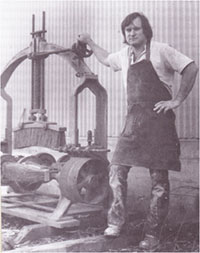MONDAY BEER LINKS, MUSING 02.24.14
One point I tried to make at the UK Craft Writing symposium is that every writer makes a choice about what to say and how to say it. The ease with which multi-media content can be delivered via the Internet sometimes changes the equation.
I included a clip of Sierra Nevada’s open fermentation video that went viral last month, and joked, but perhaps not clearly enough, that you could just shoot me now. How could a writer capture the power of that message? I should have added that trying is part of the job.
 I finished the presentation by showing this oft-published photo of Jack McAuliffe that not long ago was on the cover of All About Beer magazine. The photo does not appear in the advance copy of “The Craft Beer Revolution: How a Band of Microbrewers Is Transforming the World’s Favorite Drink” I’ve seen. Instead, Steve Hindy brings the words big time, writing:
I finished the presentation by showing this oft-published photo of Jack McAuliffe that not long ago was on the cover of All About Beer magazine. The photo does not appear in the advance copy of “The Craft Beer Revolution: How a Band of Microbrewers Is Transforming the World’s Favorite Drink” I’ve seen. Instead, Steve Hindy brings the words big time, writing:
“A wonderful photo of McAuliffe shows him leaning, with one muscled arm, on an ancient cast-iron keg-cleaning contraption that looks more like a medieval torture device, all big screws, brushes, and wheels. He is the picture of a noble pioneering craft brewer, with a square jaw, level gaze, and thick dark hair falling over his ears and across his forehead. He’s wearing a short-sleeved collared shirt and a leather apron. His jeans are splattered with what must be whitewash or paint. His smile is as enigmatic as the Mona Lisa’s, I kid you not.”
I thought about this Friday when I was reading about the “California Brew Masters” book project that photographer Nicholas Gingold has mounted a Kickstarter campaign to fund. His goal is to publish a coffee table book full of photos — his samples are stunning — along with stories from the brewers. Literally at the same time I was admiring that artwork Max Bahnson’s “Monday Afternoon Blues” post popped into my feed reader. It’s worth your time.
It was a big week for links, so I won’t be keeping it to five. (In addition, there are links to numerous posts about the conference in my own related submission last Wednesday.)
– What Makes a Brewery Good? Boak & Bailey host another round of “go long” posts on Saturday. Busy week ahead here so I may have to sit it out. But if at all possible I plan to write at length about “what makes an expert” because one of the keys to the Beer Graphs data-driven posts (like this one) is the data itself. Rating the quality of a beer is not as easy as tracking fly balls and ground balls. Yes, yes, I know there’ more than that to sabermetrics — I own a copy of Bill James “1977 Baseball Abstract” —. My point is we’re talking subjective and objective, and what Nate Silver calls “Dark Matter.” [Via Beer Graphs]
– Journalists Banned from Tasting Domaine Huet Wines. Imagine something like this happening at GABF. [Via Vinography]
– August Schell Announces a New Genre of Beer: German Craft. Without much fanfare they have added that tag on their home page. [Via The Growler]
– Does New Zealand Have Its Own Beer Style Or Flavour? Zinzan Brooke making a New Zealand beer in the UK using NZ hops and malt. What does that mean? [Via Luke’s Beer]
– The Coolships Have Landed. “We’ve calculated that we’ve already spent around $75,000 on our spontaneous program. We don’t even hope to release spontaneously fermented beer until 2016, and it could take much longer,” says Jeffrey Stuffings at Jester King Brewing in Texas. [Via Table Matters]
– The discreet charm offensive of the BrewDoggies. In case you thought only American breweries could talk trash, grow fast, and — oh, by the way — put their money where their mouth is when it comes to spending on quality control, then read Martyn Cornell’s report from the belly of the beast. [Via Zythophile] And this thought from the same junket: “But you know, I don’t think that matters so much as the fact that these guys are beer people through and through and unafraid to say so. Beer people, even when they don’t brew cask are invariably impressive. It was good to hang out with them for a bit.” [Via Tandleman’s Beer Blog]
– Demystifying the craft beer movement. In the UK, and, well, maybe. [Via The Morning Advertiser]
– “Water Is Essential to What We Do” San Diego breweries and the California drought. [Via Voice of San Diego]
– How Breweries Kept Busy During Prohibition. This is why we own a “Bud Brand” frozen eggs product tin. [Via Mental Floss]

 I finished the presentation by showing this oft-published photo of Jack McAuliffe that not long ago was on the cover of All About Beer magazine. The photo does not appear in the advance copy of
I finished the presentation by showing this oft-published photo of Jack McAuliffe that not long ago was on the cover of All About Beer magazine. The photo does not appear in the advance copy of